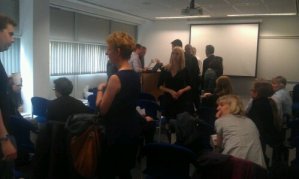Recently, I travelled to London for the CILIP Executive Briefing on eCopyright for Libraries and Archives (#ecopy 12). Arriving at Marlyebone station at the height of rush hour, I passed on the walking map being offered to the public and made a beeline to the Bakerloo line.
Due to frequent disruptions on the line and sardine-packed trains, I abandoned the Underground and headed for the nearest taxi to take me to the CILIP headquarters.
It was a journey worth making.
Nick Poole from the Collections Trust opened the day with a keynote speech which gave a complex overview of what is happening in Europe and, ultimately, the UK.
He suggested that a lot of debate about copyright isn’t about copyright at all but about “bigger issues of democracy and economic development, many of which are brought into the focus of technology.” In essence, the discussion is about contract law (licensing) and civil rights.
ACTA (Anti-Counterfeiting Trade Act) has been signed by the EU but not yet ratified. Not surprisingly, opponents to ACTA have organised themselves via social networks (like the SOPA (Stop Online Piracy Act) opponents in the US). In it’s current form, ACTA may not see the light of day.
Also on the subject of Europe, we also heard from Georgia Angelaki, Business and Policy Coordinator, about the Europeana project. More about this project in a future post.
Back to the UK, Naomi Korn, gave an excellent presentation on the Hargreaves Review of Intellectual Property (IP). She suggested that not all of the Hargreaves, recommendations will be adopted (for example data & text mining). It is also realistic to expect that contract law will continue to override education exceptions.
Ben White, Head of IP at the British Library, spoke about the definitions and issues regarding “orphan” works. These are works that are still in copyright, but whose owners cannot be traced or contacted if they have been identified. The EU draft directive is under review and might not be implemented in its current form, if at all.
Emily Goodhand brought to life several points about EU directives and UK case law, explaining how the legal system works. The devil is in the detail, particularly when it comes to big questions for the courts, such as what does “communication to the public” really mean? Where does infringement happen (jurisdiction/territory), and how temporary is “temporary?”
We also heard from Heather Caven, Head of Collections Management and Resource Planning and Roxanne Peters, Project Manager: Rights Management, about rights management and how they have adopted a holistic approach at the V&A. They stressed the importance of clear IP strategies and guidelines to ensure that your rights management doesn’t end up resembling the Winchester Mystery House. This 160 room house was constructed with 147 builders and 0 Architects. Needless to say, there were many doors leading to nowhere and skylights on the floors.
Lastly, Sarah Fahmy from the Strategic Content Alliance, communicated to us the importance of sustainability, especially after the economic crisis. One of the case studies was the Southhampton Library Digitisation Unit. Initially, it was set up with the purpose of providing a mass digitisation service to external clients. However, over time the changing market led to a change in its business model. The service dedicated itself to meeting institutional needs.
Reflecting on all the presentations from that day, I still feel uncertain about the effectiveness of the Hargreaves review in closing the gap between the rightsholders /publishers of content and those who wish to repurpose it for educational, library, and archival purposes.
Descending back into the Underground’s claustrophobic depths, it amazed me how a complex transport system originally built by the Victorians continues to operate in the 21st century, for better or worse (in my case). I also agree that copyright is a symptom of a bigger problem. This challenge is the massive gap between using technology to support innovation and the law which hasn’t kept up at the same pace.
Yes I do mind the gap, and will continue for some time in the future to watch my step. On the ground, it still remains a question of risk management.
Copyright: © Thinkstock







